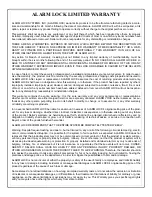
6
Terminology Used in this Manual
Before reading this section, you may wish to first read
the "
Lock Design Overview
" on page 5 for the basics.
For a description of all features, see the DL-Windows
User's Guide, OI237 or the Wireless Network Setup &
DL-Windows Configuration Instructions, OI352.
What is a
Lock Program
?
A Lock Program contains the instructions that a lock
uses to perform its various functions. Use DL-Windows
(defined below) to create a Lock Program on your com-
puter, and then transfer and store the Lock Program in
the circuitry (firmware) contained inside the lock itself.
The Lock Program is essentially a computer database
file that maintains feature settings, proximity card data,
schedules, audit trails, etc. Using DL-Windows, Lock
Programs (called a "Lock Profile" in DL-Windows) can be
created with default information, edited on your PC, and
then sent to (or received from) locks.
The
Lock Program
consists of 4 areas:
Prox Card En-
tries
,
Features
,
Time Zones
, and
Schedules
, all de-
fined below:
What are
Prox Card Entries
?
Because this lock does not have a keypad, proximity
cards and/or fobs can be added to the Lock Program to
allow entry (to allow the PL6100 to unlock). The prox-
imity card entries are a part of the Lock Program, and the
Lock Program is stored in the lock circuitry (firmware)
awaiting the Users to present their programmed prox-
imity cards.
What are
Features
?
Your lock is designed to support many options and func-
tions. Using DL-Windows software (the
Programmable
Features
window), you can select the features you wish
to activate, such as if the lock will automatically adjust for
Daylight Saving Time in the spring and autumn, or if the
lock sounder should be disabled or enabled.
Note:
Fea-
tures may only be added via DL-Windows
What are Schedules and TimeZones?
You can use DL-Windows to add simple "Schedules" to
your lock. Schedules are events (recorded lock activi-
ties) that are assigned to occur automatically at specific
times. For example, you can program the lock to allow
certain Users access ONLY on Wednesdays.
DL-Windows multiplies your flexibility, allowing the crea-
tion of many different combinations of Scheduled events
to suit the needs of your various installations. For exam-
ple, you can program the lock to allow Group 1 Users
access ONLY during specific business hours (unlock at
9AM, lock at noon for lunch, unlock at 1PM, and lock
again at 5PM--every weekday).
In addition, DL-Windows makes Schedule creation much
easier. In DL-Windows, use the "
Schedule - TimeZone
"
screen to first create an individual block of time called a
"TimeZone" (for example, "9AM to noon weekdays"). A
TimeZone is then linked to an event to make a Schedule
(for example, "unlock between 9AM and noon week-
days"). To make Scheduling easier, DL-Windows allows
TimeZones to be created, named and saved for the fu-
ture, to be easily assigned to different events and added
to multiple locks as needed. For more details, see the
DL-Windows User's Guide, OI237 or the Wireless Net-
work Setup & DL-Windows Configuration Instructions,
OI352.
What is a
User
?
A User is a person who is authorized to operate or make
certain programming changes to the lock. This User can
be anyone--from a one-time visitor in possession of a
temporary proximity card (who will almost certainly have
no authority to make changes) to the owner of the build-
ing in which the lock is installed (who will almost certainly
wish to have authority to make programming changes).
The PL Series locks can hold up to 5000 "basic" Users in
its programming memory, that means you can have up to
5000 Users each in possession of a proximity card or
fob.
What is a
Programming Level
?
With other Trilogy locks that possess keypads (such as
the PDL3000, ETPDL, etc.), the Programming Level de-
fines the range of programming tasks a User is allowed
to perform using the keypad. However, the PL6100 lock
does not include a keypad, and changes to the PL6100
Lock Program are initiated only with DL-Windows.
Therefore, access to the DL-Windows computer pro-
gram, with a valid password, is the sole means for deter-
mining who can make changes to the Lock Program.
The DL-Windows program and its access passwords
must be safeguarded, as it is essential to the secu-
rity of the lock.
What is a
User Number
?
(
User Number
=
Location Number
=
User Location =
"Slot" in Lock
)
User Numbers are used primarily with DL-Windows, and
are significant within each individual lock only. PL Series
locks can hold up to 5000 proximity cards in its program-
ming memory, and these cards can be thought of as sim-
Summary of Contents for Wireless Trilogy Networx PL6100
Page 15: ...15 NOTES ...


































